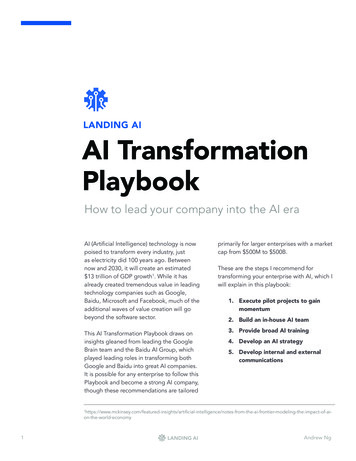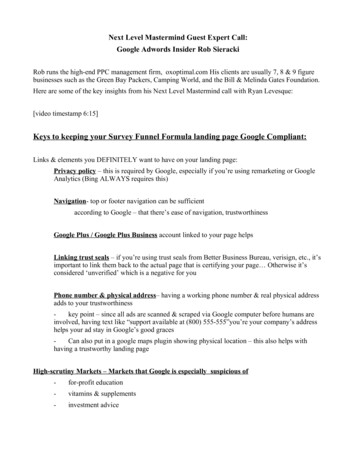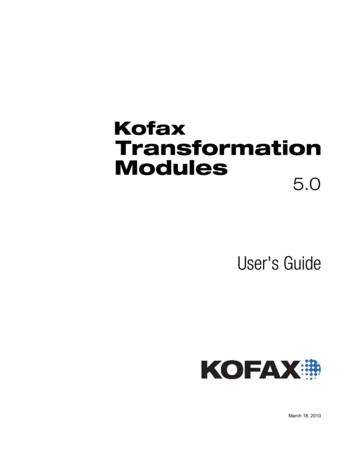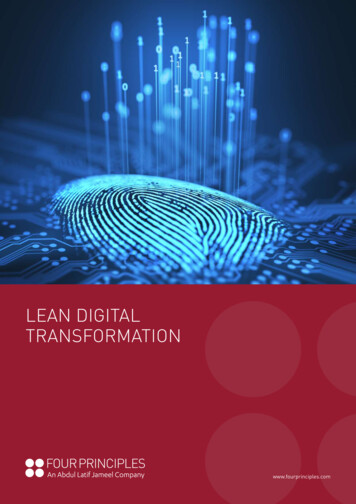
Transcription
LANDING AIAI TransformationPlaybookHow to lead your company into the AI eraAI (Artificial Intelligence) technology is nowpoised to transform every industry, justas electricity did 100 years ago. Betweennow and 2030, it will create an estimated 13 trillion of GDP growth1. While it hasalready created tremendous value in leadingtechnology companies such as Google,Baidu, Microsoft and Facebook, much of theadditional waves of value creation will gobeyond the software sector.This AI Transformation Playbook draws oninsights gleaned from leading the GoogleBrain team and the Baidu AI Group, whichplayed leading roles in transforming bothGoogle and Baidu into great AI companies.It is possible for any enterprise to follow thisPlaybook and become a strong AI company,though these recommendations are tailoredprimarily for larger enterprises with a marketcap from 500M to 500B.These are the steps I recommend fortransforming your enterprise with AI, which Iwill explain in this playbook:1. Execute pilot projects to gainmomentum2. Build an in-house AI team3. Provide broad AI training4. Develop an AI strategy5. Develop internal and rld-economy11Andrew Ng
1. Execute pilot projects to gainmomentumIt is more important for your first few AI projects to succeed rather than be the most valuable AIprojects. They should be meaningful enough so that the initial successes will help your companygain familiarity with AI and also convince others in the company to invest in further AI projects;they should not be so small that others would consider it trivial. The important thing is to get theflywheel spinning so that your AI team can gain momentum.Suggested characteristics for the first few AI projects: It should ideally be possible for a new or external AI team (which may not have deep domainknowledge about your business) to partner with your internal teams (which have deepdomain knowledge) and build AI solutions that start showing traction within 6-12 months.The project should be technically feasible. Too many companies are still starting projects thatare impossible using today’s AI technology; having trusted AI engineers do due diligence ona project before kickoff will increase your conviction in its feasibility.Have a clearly defined and measurable objective that creates business value.When I was leading the Google Brain team, there was significant skepticism within Google (andmore broadly, around the world) of deep learning technology. To help the team gain momentum,I chose the Google Speech team as my first internal customer, and we worked closely with themto make Google Speech recognition much more accurate. Speech recognition is a meaningfulproject within Google, but not the most important one—for example, it is less important to thecompany bottom line than applying AI to web search or advertising. But by making the Speechteam more successful using deep learning, other teams started to gain faith in us, which enabledthe Google Brain team to gain momentum.Once other teams started to see the success of Google Speech working with Google Brain,we were able to acquire more internal customers. The team’s second major internal customerwas Google Maps, which used deep learning to improve the quality of map data. With twosuccesses, I started conversations with the advertising team. Building up momentum graduallyled to more and more successful AI projects. This process is a repeatable model that you can usein your company.2Andrew Ng
2. Build an in-house AI teamWhile outsourced partners with deep technical AI expertise can help you gain that initialmomentum faster, in the long term it will be more efficient to execute some projects with an inhouse AI team. Further, you will want to keep some projects within the company to build a moreunique competitive advantage.It is important to have buy-in from the C-suite to build this internal team. During the rise of theinternet, hiring a CIO was a turning point for many companies to have a cohesive strategy forusing the internet. In contrast, the companies that ran many independent experiments—rangingfrom digital marketing to data science experiments to new website launches—failed to leverageinternet capabilities if these small pilot projects did not manage to scale to transform the rest ofthe company.In the AI era, a key moment for many companies will again be the formation of a centralized AIteam that can help the whole company. This AI team could sit under the the CTO, CIO, or CDO(Chief Data Officer or Chief Digital Officer) function if they have the right skillset. It could also beled by a dedicated CAIO (Chief AI Officer). The key responsibilities of the AI unit are: 3Build up an AI capability to support the whole company.Execute an initial sequence of cross-functional projects to support different divisions/business units with AI projects. After completing the initial projects, set up repeatedprocesses to continuously deliver a sequence of valuable AI projects.Develop consistent standards for recruiting and retention.Develop company-wide platforms that are useful to multiple divisions/business units and areunlikely to be developed by an individual division. For example, consider working with theCTO/CIO/CDO to develop unified data warehousing standards.Andrew Ng
Many companies are organized with multiple business units reporting to the CEO. With a newAI unit, you’ll be able to matrix in AI talent to the different divisions to drive cross-functionalprojects.New job descriptions and new team organizations will emerge. The way I now organize the workof my teams in roles like a Machine Learning Engineer, Data Engineer, Data Scientist, and AIProduct Manager is different than the pre-AI era. A good AI leader will be able to advise you onsetting up the right processes.There is currently a war for AI talent, and unfortunately most companies will have a hard timehiring a Stanford AI PhD student (or perhaps even a Stanford AI undergrad). Since the talent waris largely zero-sum in the short term, working with a recruiting partner that can help you build anAI team will give you a non-trivial advantage. However, providing training to your existing teamcan also be a good way to create a lot of new talent in-house.4Andrew Ng
3. Provide broad AI trainingNo company today has enough in-house AI talent. While the media reports of high AI salariesare over-hyped (the numbers quoted in press tend to be outliers), AI talent is hard to find.Fortunately, with the rise of digital content, including MOOCs (massive open online courses)such as Coursera, ebooks, and YouTube videos, it is more cost effective than ever to train uplarge numbers of employees in new skills such as AI. The smart CLO (Chief Learning Officer)knows that their job is to curate, rather than create content, and then to establish processes toensure employees complete the learning experiences.Ten years ago, employee training meant hiring consultants to come to your office to givelectures. But this was inefficient, and the ROI was unclear. In contrast, digital content is muchmore affordable and also gives employees a more personalized experience. If you do have thebudget to hire consultants, the in-person content should complement the online content. (Thisis called the “flipped classroom” pedagogy. I have found that, when implemented correctly, thisresults in faster learning and a more enjoyable learning experience. For example, at StanfordUniversity, my on-campus deep learning class is taught using this form of pedagogy.) Hiring afew AI experts to deliver some in-person content can also help motivate your employees to learnthese AI techniques.AI will transform many different jobs. You should give everyone the knowledge they will needto adapt to their new roles in the AI era. Consulting with an expert will allow you to develop acustomized curriculum for your team. However, a notional education plan may look like this:1. Executives and senior business leaders: ( 4 hours training)Goal: Enable executives to understand what AI can do for your enterprise, begin developing AIstrategy, make appropriate resource allocation decisions, and collaborate smoothly with an AIteam that is supporting valuable AI projects.Curriculum: Basic business understanding of AI including basic technology, data, and what AI can andcannot do. Understanding of AI’s impact on corporate strategy. Case studies on AI applications to adjacent industries or to your specific industry.5Andrew Ng
2. Leaders of divisions carrying out AI projects: ( 12 hours training)Goal: Division leaders should be able to set direction for AI projects, allocate resources, monitorand track progress, and make corrections as needed to ensure successful project delivery.Curriculum: Basic business understanding of AI including basic technology, data, and what AI can andcannot do. Basic technical understanding of AI, including major classes of algorithms and theirrequirements. Basic understanding of the workflow and processes of AI projects, roles and responsibilitiesin AI teams, and management of AI team.3. AI engineer trainees: ( 100 hours training)Goal: Newly trained AI engineers should be able to gather data, train AI models, and deliverspecific AI projects.Curriculum: Deep technical understanding of machine learning and deep learning; basic understandingof other AI tools. Understanding of available (open-source and other 3rd party) tools for building AI and datasystems. Ability to implement AI teams’ workflows and processes. Additionally: Ongoing education to keep up-to-date with evolving AI technology.6Andrew Ng
4. Develop an AI strategyAn AI strategy will guide your company toward creating value while also building defensiblemoats. Once teams start to see the success of the initial AI projects and form a deeperunderstanding of AI, you will be able to identify the places where AI can create the most valueand focus resources on those areas.Some executives will think that developing an AI strategy should be the first step. In myexperience, most companies will not be able to develop a thoughtful AI strategy until it has hadsome basic experience with AI, which partial progress in steps 1-3 will give you.The way you build defensible moats is also evolving with AI. Here are some approaches toconsider:Build several difficult AI assets that are broadly aligned with a coherent strategyAI is enabling companies to build unique competitive advantages in new ways. Michael Porter’sseminal writings on business strategy show that one way to start a defensible business is to buildseveral difficult assets that are broadly aligned with a coherent strategy. It thus becomes difficultfor a competitor to replicate all of these assets simultaneously.Leverage AI to create an advantage specific to your industry sectorRather than trying to compete “generally” in AI with leading tech companies such as Google, Irecommend instead becoming a leading AI company in your industry sector, where developingunique AI capabilities will allow you to gain a competitive advantage. How AI affects yourcompany’s strategy will be industry- and situation-specific.Design strategies aligned with the “Virtuous Circle of AI” positive-feedback loopIn many industries, we will see data accumulation leading to a defensible business.7Andrew Ng
For example, leading web search engines such as Google, Baidu, Bing and Yandex have a hugedata asset showing them what links a user clicks on after different search queries. This datahelps the companies build a more accurate search engine product (A), which in turn helps themacquire more users (B), which in turn results in their having even more user data (C). This positivefeedback loop is hard for competitors to break into.Data is a key asset for AI systems. Thus, many great AI companies also have a sophisticateddata strategy. Key elements of your data strategy may include: 8Strategic data acquisition: Useful AI systems can be built with anywhere from100 data points (“small data”) to 100,000,000 data points (“big data”). Buthaving more data almost never hurts. AI teams are using very sophisticated,multi-year strategies to acquire data, and specific data acquisition strategiesare industry- and situation-specific. For example, Google and Baidu bothhave numerous free products that do not monetize but allow them toacquire data that can be monetized elsewhere.Unified data warehouses: If you have 50 different databases siloed underthe control of 50 different VPs or divisions, it will be nearly impossible foran engineer or for AI software to get access to this data and “connect thedots.” Instead, consider centralizing your data into one or at most a smallnumber of data warehouses.Andrew Ng
Recognize what data is valuable, and what is not: It is not true that havingmany terabytes of data automatically means an AI team will be able tocreate value from that data. Expecting an AI team to magically create valuefrom a large dataset is a formula that comes with a high chance of failure,and I have tragically seen CEOs over-invest in collecting low-value data, oreven acquire a company for its data only to realize the target company’smany terabytes of data is not useful. Avoid this mistake by bringing an AIteam in early during your process of data acquisition, and let them help youprioritize what types of data to acquire and save.Create network effect and platform advantagesFinally, AI can also be used to build more traditional moats. For example, platforms with networkeffects are highly defensible businesses. They often have a natural “winner takes all” dynamicthat forces companies to either grow fast or die. If AI allows you to acquire users faster thanyour competitors, it could be leveraged into building a moat that is defensible through platformdynamics. More broadly, you can also use AI as a key component of low cost strategy, highvalue, or other business strategies.9Andrew Ng
5. Develop internal and externalcommunicationsAI will affect your business significantly. To the extent that it affects your key stakeholders, youshould run a communications program to ensure alignment. Here is what you should consider foreach audience:Investor RelationsLeading AI companies such as Google and Baidu are now much more valuable companies inpart because of their AI capabilities and the impact that AI has on their bottom lines. Explaininga clear value creation thesis for AI in your company, describing your growing AI capabilities, andhaving a thoughtful AI strategy will help investors value your company appropriately.Government RelationsCompanies in highly regulated industries (self-driving cars, healthcare) face unique challengesto stay compliant. Developing a credible, compelling AI story that explains the value andbenefits your project can bring to an industry or society is an important step in building trustand goodwill. This should be coupled with direct communication and ongoing dialogue withregulators as you rollout your project.Customer/User EducationAI will likely bring significant benefits to your customers, so make sure the appropriate marketingand product roadmap messages are disseminated.Talent/RecruitmentBecause of the scarcity of AI talent, strong employer branding will have a significant effecton your ability to attract and retain such talent. AI engineers want to work on exciting andmeaningful projects. A modest effort to showcase your initial successes can go a long way.Internal CommunicationsBecause AI today is still poorly understood and Artificial General Intelligence specifically hasbeen over-hyped, there is fear, uncertainty and doubt. Many employees are also concernedabout their jobs being automated by AI, though this varies widely by culture (for example, thisfear appears much more in the US than in Japan). Clear internal communications both to explainAI and to address such employees’ concerns will reduce any internal reluctance to adopt AI.10Andrew Ng
A historical note, important to yoursuccessUnderstanding how the internet transformed industries is useful for navigating the rise of AI.There is a mistake that many businesses made navigating the rise of the internet that I hope youwill avoid as you navigate the rise of AI.We learned in the internet era that:shopping mall website internet companyEven if a shopping mall built a website and sold things on a website, that by itself did not turnthe shopping mall into a true internet company. What defines a true internet company is: Haveyou organized your company to do the things that the internet lets you do really well?For example, internet companies engage in pervasive A/B testing, in which we routinely launchtwo versions of a website and measure which works better. An internet company may evenhave hundreds of experiments running at the same time; this is very hard to do with a physicalshopping mall. Internet companies can also ship a new product every week and thus learnmuch faster than a shopping mall that might update its design only once per quarter. Internetcompanies have unique job descriptions for roles such as product manager and softwareengineer, and those jobs have unique workflows and processes for how they work together.Deep learning, one of the fastest growing areas of AI, is showing parallels to the rise of theinternet. Today, we find that:any typical company deep learning technology AI companyFor your company to become great at AI, you will have to organize your company to dothe things that AI lets you do really well.11Andrew Ng
For your company to be great at AI, you must have: Resources to systematically execute on multiple valuable AI projects: AI companies havethe outsourced and/or in-house technology and talent to systematically execute on multipleAI projects that deliver direct value to the business.Sufficient understanding of AI: There should be general understanding of AI, withappropriate processes in place to systematically identify and select valuable AI projects towork on.Strategic direction: The company’s strategy is broadly aligned to succeed in an AI-poweredfuture.Turning your great company into a great AI company is challenging but feasible with thesupport of great partners. My team at Landing AI is committed to helping partners with their AItransformations, and I will continue to share additional best practices.An AI Transformation program may take 2-3 years, but you should expect to see initial concreteresults within 6-12 months. By investing in an AI transformation, you will stay ahead of yourcompetitors and leverage AI capabilities to significantly advance your company.I welcome your feedback on this article at transformation@landing.ai.Andrew NgChairman and CEO, Landing AI12Andrew Ng
AI Transformation Playbook How to lead your company into the AI era AI (Artificial Intelligence) technology is now poised to transform every industry, just as electricity did 100 years ago. Between now and 2030, it will create an estimated 13 trillion of GDP growth1.










